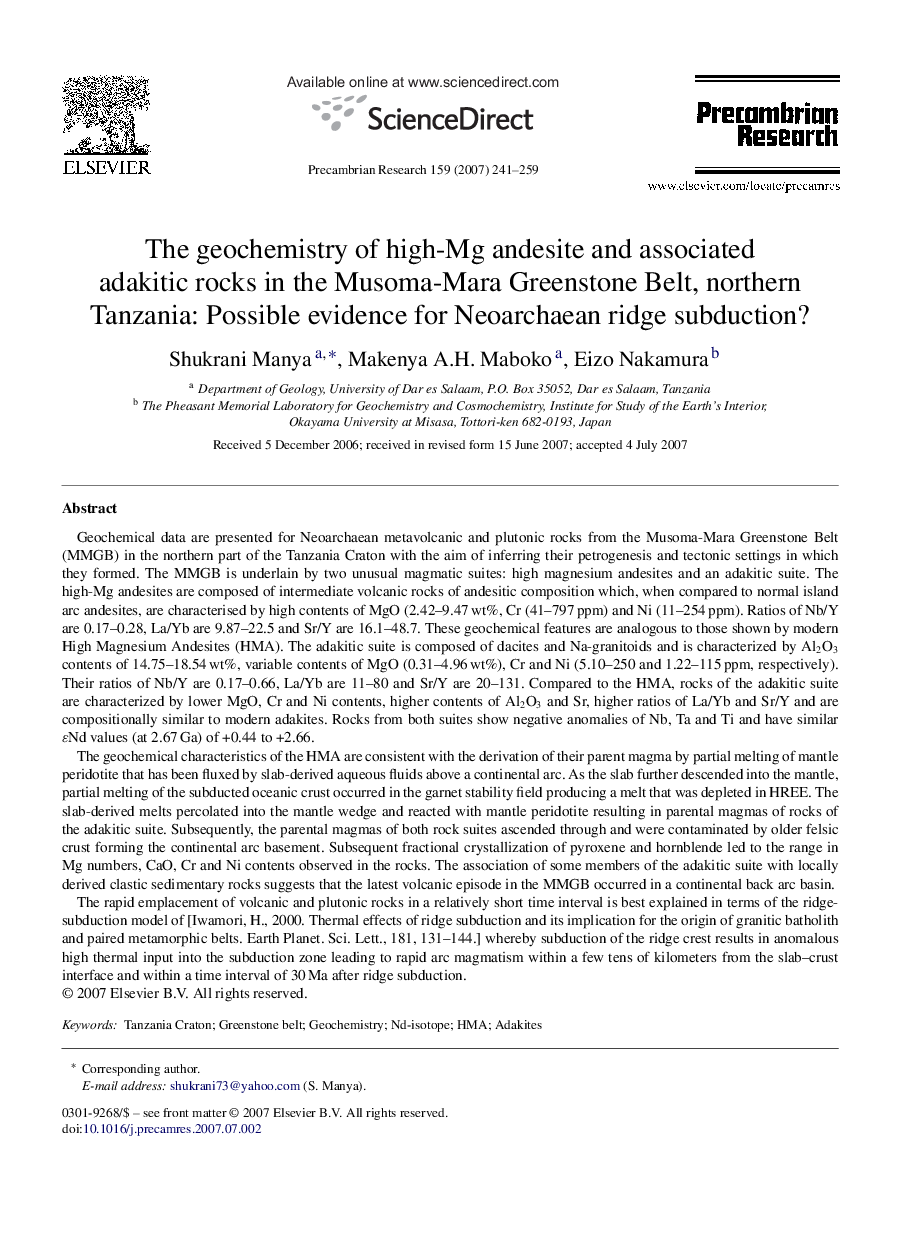| کد مقاله | کد نشریه | سال انتشار | مقاله انگلیسی | نسخه تمام متن |
|---|---|---|---|---|
| 4724398 | 1639711 | 2007 | 19 صفحه PDF | دانلود رایگان |

Geochemical data are presented for Neoarchaean metavolcanic and plutonic rocks from the Musoma-Mara Greenstone Belt (MMGB) in the northern part of the Tanzania Craton with the aim of inferring their petrogenesis and tectonic settings in which they formed. The MMGB is underlain by two unusual magmatic suites: high magnesium andesites and an adakitic suite. The high-Mg andesites are composed of intermediate volcanic rocks of andesitic composition which, when compared to normal island arc andesites, are characterised by high contents of MgO (2.42–9.47 wt%, Cr (41–797 ppm) and Ni (11–254 ppm). Ratios of Nb/Y are 0.17–0.28, La/Yb are 9.87–22.5 and Sr/Y are 16.1–48.7. These geochemical features are analogous to those shown by modern High Magnesium Andesites (HMA). The adakitic suite is composed of dacites and Na-granitoids and is characterized by Al2O3 contents of 14.75–18.54 wt%, variable contents of MgO (0.31–4.96 wt%), Cr and Ni (5.10–250 and 1.22–115 ppm, respectively). Their ratios of Nb/Y are 0.17–0.66, La/Yb are 11–80 and Sr/Y are 20–131. Compared to the HMA, rocks of the adakitic suite are characterized by lower MgO, Cr and Ni contents, higher contents of Al2O3 and Sr, higher ratios of La/Yb and Sr/Y and are compositionally similar to modern adakites. Rocks from both suites show negative anomalies of Nb, Ta and Ti and have similar ɛNd values (at 2.67 Ga) of +0.44 to +2.66.The geochemical characteristics of the HMA are consistent with the derivation of their parent magma by partial melting of mantle peridotite that has been fluxed by slab-derived aqueous fluids above a continental arc. As the slab further descended into the mantle, partial melting of the subducted oceanic crust occurred in the garnet stability field producing a melt that was depleted in HREE. The slab-derived melts percolated into the mantle wedge and reacted with mantle peridotite resulting in parental magmas of rocks of the adakitic suite. Subsequently, the parental magmas of both rock suites ascended through and were contaminated by older felsic crust forming the continental arc basement. Subsequent fractional crystallization of pyroxene and hornblende led to the range in Mg numbers, CaO, Cr and Ni contents observed in the rocks. The association of some members of the adakitic suite with locally derived clastic sedimentary rocks suggests that the latest volcanic episode in the MMGB occurred in a continental back arc basin.The rapid emplacement of volcanic and plutonic rocks in a relatively short time interval is best explained in terms of the ridge-subduction model of [Iwamori, H., 2000. Thermal effects of ridge subduction and its implication for the origin of granitic batholith and paired metamorphic belts. Earth Planet. Sci. Lett., 181, 131–144.] whereby subduction of the ridge crest results in anomalous high thermal input into the subduction zone leading to rapid arc magmatism within a few tens of kilometers from the slab–crust interface and within a time interval of 30 Ma after ridge subduction.
Journal: Precambrian Research - Volume 159, Issues 3–4, 15 November 2007, Pages 241–259